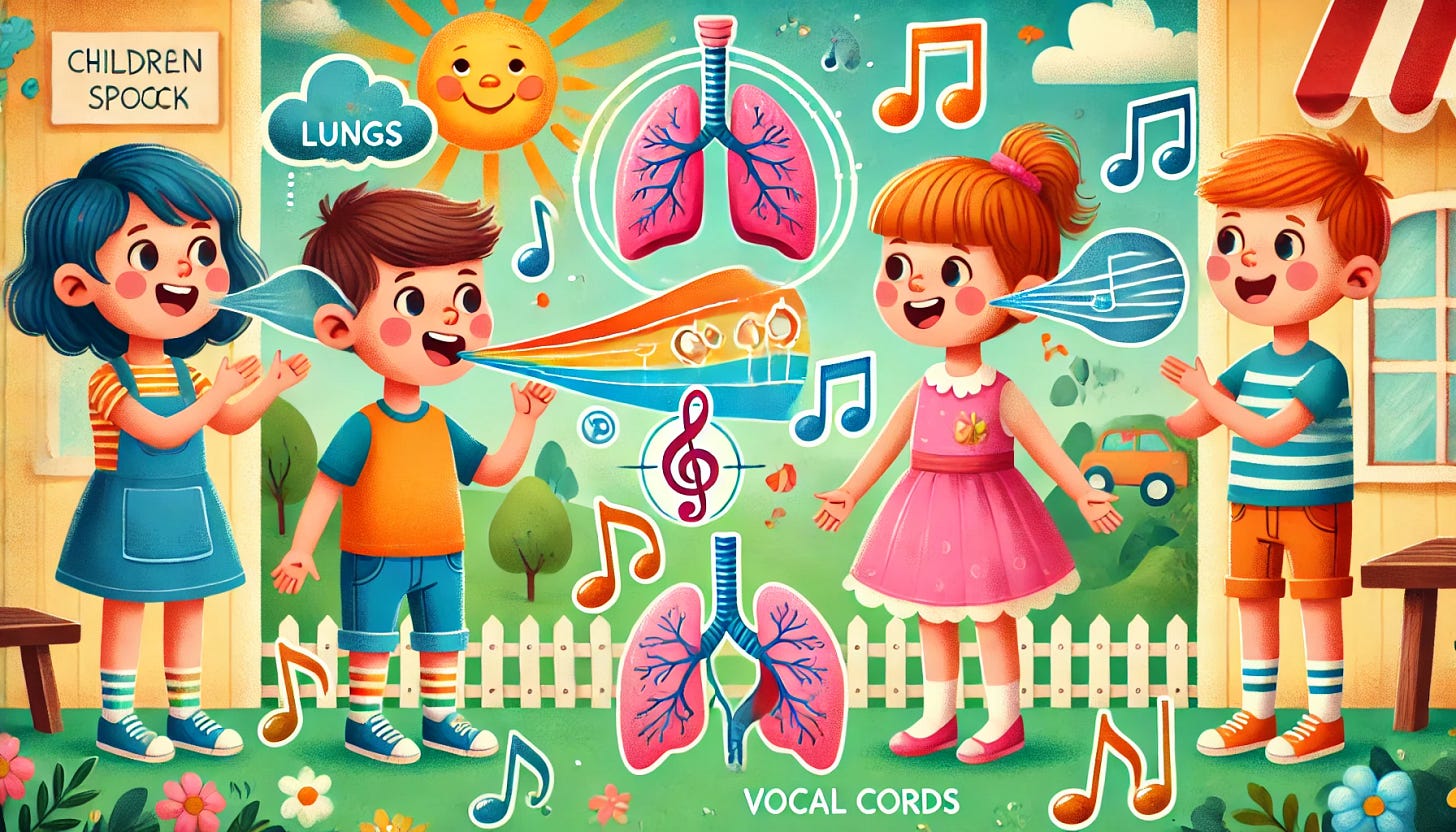How Do Humans Make Speech Sounds?
Have you ever wondered how people talk or sing? It’s like having a magic instrument right inside your body! Talking and singing are two amazing things humans can do with their voices, but they work in slightly different ways. Let’s explore how we make speech sounds and compare them to singing songs. Are you ready? Let’s dive in!
Hello my friends!
For a quick note, welcome to Tidbits with Titus, a podcast and newsletter where we tackle the big, curious questions kids ask every day in fun, bite-sized ways! I’m Alexander Titus, but I go by Titus. I’m a scientist, adventurer, and a huge fan of making science, technology, and life accessible to all ages. From “How does electricity work?” to “What are taxes?” and even “Why is the sky blue?” I’m here to dive into these wonder-filled questions with engaging stories and simple explanations that spark curiosity and make learning a joy. This effort is all about creating a space where families can learn together, discover the magic of the every day, and find thoughtful ways to explore the world’s big mysteries. Let’s make curiosity a family tradition—one tidbit at a time!
Just so you know, these podcast episodes are all AI-generated using Google’s really cool NotebookLM technology. That means there are some errors in how words are said, but that is part of the fun!
If your little ones have questions that you want help answering, shoot me an email at questions@tidbitswithtitus.com and I’ll see what I can do!
You can subscribe to the newsletter that has this information as well at tidbitswithtitus.com.
Also please share with anyone you think would be interested. The more the merrier!
Cheers,
-Titus
The Journey of Your Voice: How Talking Works
When you talk, you use different parts of your body to create sounds. These parts work together like a team. Let’s meet the team members:
1. Lungs: The Air Powerhouse
The first step to making sounds is breathing. Your lungs are like balloons that fill with air when you breathe in. When you breathe out, they push the air up through your throat. This airflow is super important because it’s the energy that powers your voice.
2. Vocal Cords: The Sound Makers
Next, the air from your lungs reaches your vocal cords. Your vocal cords are two stretchy bands of muscle inside your throat. When air passes through them, they vibrate—kind of like the strings of a guitar! These vibrations create sound. The faster the cords vibrate, the higher the sound. The slower they vibrate, the lower the sound.
3. Mouth and Nose: The Shapers
Once the sound leaves your vocal cords, it travels through your throat and into your mouth and nose. These areas shape the sound into words and different noises. Your tongue, lips, and even your teeth help shape the sounds. For example:
Lips help make sounds like “p” and “b.”
Tongue helps with sounds like “t” and “l.”
Teeth help with sounds like “th” in “thank you.”
4. Brain: The Boss
Your brain is the control center. It sends signals to your lungs, vocal cords, tongue, and lips, telling them how to work together to create specific sounds. Without your brain’s guidance, you couldn’t talk at all!
How Singing is Different (and the Same)
Now that you know how talking works, let’s look at singing. Singing and talking use the same body parts, but there are some differences.
1. Pitch Control
When you talk, your voice usually stays within a small range of pitches. But when you sing, your voice changes pitch a lot. Singing high notes and low notes depends on how tight or loose your vocal cords are. Tight cords make higher notes, and loose cords make lower notes.
It’s like playing a rubber band: stretch it tight, and it makes a high sound. Leave it loose, and it makes a lower sound.
2. Rhythm and Melody
Talking doesn’t usually follow a rhythm or melody. You just speak at a normal pace. But singing is all about rhythm and melody! When you sing, you hold some sounds longer and others shorter. You also follow patterns in music, like singing the notes “do-re-mi.”
3. Breath Control
When you talk, you take quick breaths. But when you sing, you need to control your breathing more carefully. Singers often take deep breaths and use their air slowly so they can hold long notes.
4. Emotion and Expression
Both talking and singing can express emotions. But singing often adds extra feeling. For example, a happy song might sound cheerful, while a sad song might sound soft and slow. Singers use their voices like artists use paint, adding color and emotion to their songs.
Fun Facts About Talking and Singing
Different Languages: Did you know there are over 7,000 languages in the world? Each language uses unique sounds. For example, some languages use clicks or tones to change the meaning of words.
Singing Animals: Humans aren’t the only ones who sing. Birds, whales, and even some insects can sing, too! But their songs are very different from human songs.
Whispering: When you whisper, your vocal cords don’t vibrate. Instead, you just push air through your mouth. It’s like silent talking!
Try It Yourself: Talking and Singing Experiments
Want to see how your voice works? Here are some fun experiments you can try:
1. Feel Your Vocal Cords
Put your fingers on your throat and say “ahhh.” Can you feel the vibration? That’s your vocal cords at work! Now try whispering. Do you feel a difference?
2. Change Your Pitch
Say “la-la-la” and try to make your voice go higher and lower. You’re stretching and relaxing your vocal cords, just like a singer!
3. Shape Sounds with Your Mouth
Say “p,” “b,” “t,” and “d.” Notice how your lips and tongue move? Try making up your own silly sounds by moving your mouth in different ways.
4. Sing a Simple Song
Choose your favorite song and sing it slowly. Pay attention to how you breathe and change pitch. Can you add extra emotion to make it even better?
Why Are Talking and Singing Important?
Talking helps us share ideas, ask questions, and make friends. Singing is a way to express ourselves, tell stories, and connect with others. Both are super special because they let us communicate in creative ways.
Think about your favorite songs or conversations. How do they make you feel? Whether you’re talking to a friend or singing along to a tune, your voice is an incredible tool that helps you share who you are with the world.
In Conclusion
Talking and singing might seem similar, but they have their own unique features. Talking is like having a conversation, while singing is like painting a picture with your voice. Both use your lungs, vocal cords, and mouth to create amazing sounds. Next time you talk or sing, remember how hard your body is working to help you communicate.
Isn’t it cool to have your own built-in sound system?














Share this post